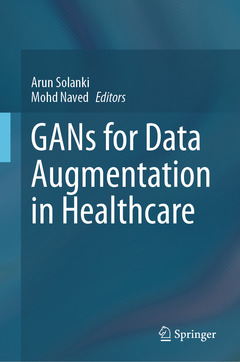GANs for Data Augmentation in Healthcare, 1st ed. 2023
Coordonnateurs : Solanki Arun, Naved Mohd

Computer-Assisted Diagnostics (CAD) using Convolutional Neural Network (CNN) model has become an important technology in the medical industry, improving the accuracy of diagnostics. However, the lack Magnetic Resonance Imaging (MRI) data leads to the failure of the depth study algorithm. Medical records are often different because of the cost of obtaining information and the time spent consuming the information. In general, clinical data is unreliable and therefore the training of neural network methods to distribute disease across classes does not yield the desired results. Data augmentation is often done by training data to solve problems caused by augmentation tasks such as scaling, cropping, flipping, padding, rotation, translation, affine transformation, and color augmentation techniques such as brightness, contrast, saturation, and hue.
Data Augmentation and Segmentation imaging using GAN can be used to provide clear images of brain, liver, chest, abdomen, and liver on an MRI. In addition, GAN shows strong promise in the field of clinical image synthesis. In many cases, clinical evaluation is limited by a lack of data and/or the cost of actual information. GAN can overcome these problems by enabling scientists and clinicians to work on beautiful and realistic images. This can improve diagnosis, prognosis, and disease. Finally, GAN highlights the potential for location of patient information within the data. This is a beneficial clinical application of GAN because it can effectively protect patient confidentiality. This book covers the application of GANs on medical imaging augmentation and segmentation.
Oriented towards the applications and not just the theory
Contains work from some of the pioneers of GAN
Covers practical aspects with possible supported results
Date de parution : 11-2023
Ouvrage de 251 p.
15.5x23.5 cm
Disponible chez l'éditeur (délai d'approvisionnement : 15 jours).
Prix indicatif 168,79 €
Ajouter au panierThèmes de GANs for Data Augmentation in Healthcare :
Mots-clés :
GANS; Healthcare; Machine Learning; Medical Records; Generative Adversarial Network; GAN based Image Augmentation; Medical Image augmentation; Data Transformation and Augmentation using GAN; Generative Network for Image Generation; Healthcare Imaging Augmentation; Data Augmentation in Healthcare; X-ray Image augmentation; GAN Based Healthcare Image Augmentation; GANs for Dataset creation


